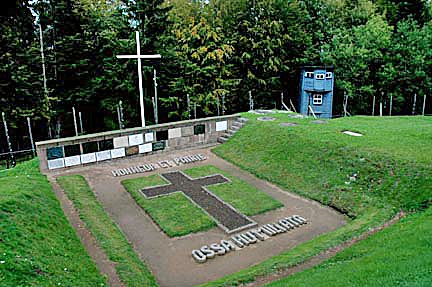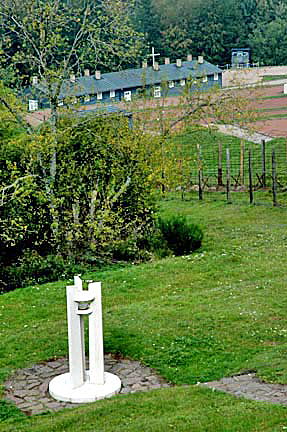Natzweiler-Struthof Ash Pit


The two photos above show the "ash
pit" behind the crematorium where the ashes of the cremated
prisoners at Natzweiler-Struthof were ignominiously thrown. A
wall with plaques in honor of the victims is shown behind the
pit. Note the two large Christian crosses: Natzweiler was not
a camp for the extermination of the Jews, but rather a prison
camp for insurgents who were captured while fighting to free
Europe from the Nazi occupation.
In a book which I purchased at the Memorial
site, the following words by Gaston Charlet are quoted:
As the memorial for deportation stands
on the soil of France at the Struthof, as the camp at Natzweiler
Struthof was one of the most terrible and one of the most radically
exterminating ones, as it must also be a mausoleum for thousands
of unidentified corpses, it must represent a little comfort for
the families of those who died and who cannot even be located
in the ground.
No, their corpses did not have the
traditional sepulture the earth usually gives to those who inhabited
it.
The rock was too hard for time to
be lost in order to dig in it. The skeletons it would have kept
would have been numerable proofs of these inexcusable murders.
They preferred to transform your bodies
into smoke, my friends, and they scattered your ashes in the
alpine valley.
As if they had wanted, sadistically
determined as they were, to keep your families from the tribute
they would have payed later on to your graves.
The photo below shows the Lantern of
the Dead which is located up the hill from the Ash Pit in an
area that was formerly the garden of the Commandant. The cross
of the Ash Pit is visible in the background, behind a building
which was used for a prison within the Natzweiler prison camp.
The Lantern for the Dead is outside the barbed wire enclosure,
which is shown on the right in the middle of the photograph.

The tradition of erecting a Lantern for
the Dead comes from the Roman times when the territory that is
now France was part of the Roman Empire.
The photo below shows a Cross of Lorraine,
which was the symbol of the Forces Françaises de l'Intérieur
(FFI), one of the French resistance groups. This cross is located
between two of the terraces where the Natzweiler barracks formerly
stood. Lorraine is a province in northern France that was annexed
into the Greater German Reich after the surrender of France in
June 1940.

In the words of Aime Spitz, one of the
survivors of the camp:
The camp of the Struthof now peacefully
overlooks the Bruche valley. It has been classified a historical
monument. The kennel is empty, the crematorium is cold forever.
But this Alsacian mountain still keeps the memory of all the
patriots murdered because they loved their country.
|